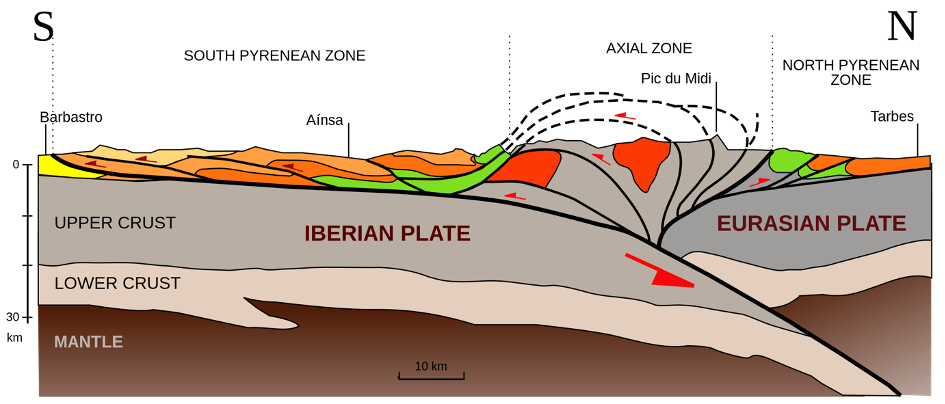Stress has most surely built up after six stages and the mighty Toumalet looming on the horizon. But did you know the earth can be stressed too? Up until the point a meltdown.
We are in the Pyrenees with climbs like Col d’Aspin (12km at 6.5% grade) and the Tourmalet (17,3km at 7,3% average). After crossing the finish line the riders and viewers can gaze upon the gorgeous Pyrenean peaks of Pic du Midi de Bigorre and the Massif du Néouveille. Thanks to plate tectonics we can view these mountains and climb then. We meet pioneer Marie Tharp later who was instrumental in this field.

The rocks of the High Pyrenees formed from continental collision and mountain building that started more than 350 million years ago. We have read about this before. The peaks of southern France and northern Spain have special records of this history. Nearby, the Massif du Néouveille is a famous example of what can happen to rocks deep in the heart of mountain ranges when they get stressed – the result of immense tectonic pressures and temperatures!
Meltdown
The mountains were stressed so they had a meltdown. Can you blame them? Rocks are just like people, after all. They get stressed. And when they get stressed—just like people—sometimes they bend, sometimes they break, and sometimes they have a meltdown. The High Pyrenees record all of it. There are bends, breaks, and meltdowns as mountains rose in response to tectonic forces and collisions that built and then ripped apart the supercontinent Pangea!
So how about that meltdown? Lots of rocks of the highest peaks are granites. These are igneous rocks that form from cooling and crystallization of melted rock. At the end of the “Variscan” mountain building event around 300 million years ago, incredible volumes of melted rock formed and entered the shallow crust. Imagine the present-day Andes, or the stories of Mount Vesuvius, with extreme and disastrous eruptions, and you’ll get halfway there. At that time, there would have been a spectacular expression at Earth’s surface (did someone say fireworks?).

Fiery window
Whatever your mind conjures when you imagine “volcano” is really just the tip of the iceberg. Beneath that volcanic surface speck is a world of fire and flame – expansive storage chambers of molten material. Today in the High Pyrenees, we have a rare opportunity to see the deeper plumbing of the volcanic system. This is because the top part has long since eroded away. A window to the fiery underworld!
In fact, geologists don’t know why there’s so much granite in the Pyrenees. It’s hard to explain the astonishing volumes of crystallized molten rock solely from melting the material that was already there. Some scientists have shown that the rocks got so hot that they themselves started melting. Others say most of the magma came from somewhere else, like the mantle. In reality, the chemistry suggests it’s both. So we get the best of both (under)worlds! Consider that next time you visit your friend who’s installed a new granite countertop in their kitchen…
What goes up, must come down. Mountains are no exception. After the 300-million-year-old melting event, the mountain range was eroded and the continents ripped and stretched apart. An ocean formed in between them. But then like an accordion, the ocean was squished and forced back into the mantle, and the mountains rose again. (also see stage 9 for the sad end of the baby ocean).
Pioneer: Mary Tharp
The continuous birth and death of the seafloor is one of the best pieces of evidence we have in support of the plate tectonic theory. It’s because of this accordion-like opening-and-closing that we can explain the mountain building processes of the past and present.
Ironically, geologists’ ability to explain the formation of the tallest mountains, comes from observations from some of the deepest places on the planet: the ocean floor.

Who knew that mapping the ocean floor would teach us about mountain formations? This is credited to Marie Tharp. She was a renowned American geologist and oceanographic cartographer whose seafloor maps forced the paradigm shift and acceptance of plate tectonics.
Before the 1950’s, we knew less about the seafloor than we did about the surface of the moon. But Tharp used sounding profiles acquired by United States Navy submarines across segments of the North Atlantic Ocean and noticed a consistent V-shaped divot that consistently reappeared in the bathymetry.
And thus, Tharp discovered the Mid-Atlantic Ridge – the longest continuous volcanic chain on the planet. A rift valley that marked the seam along which the seafloor was tearing apart, continuously birthing new seafloor. The more she looked, the more she noticed the axis of spreading ran continuously around the globe like seams on a baseball.

With this discovery, other pieces of the plate tectonic puzzle fell into place with a Big Bam. Finally, the explanations for colossus clout of continental drift, locations of earthquakes and volcanoes, all made sense. And it is because of the movements of plates—the birth and death of oceans, and the slow-motion car-crash collisions between continental chunks—that we have mountains on Earth.
Girl talk
Tharp’s legacy will stand the test of time. She persevered in a time when women were not only discouraged from science, but explicitly discounted from fieldwork opportunities. Ideas were dismissed as “girl talk”. Her ventures into uncharted territory of her time – both geologic and professional – earn her a renowned position in the science hall of fame.





